Answer these simple questions and we will find you the BEST prices
Which type of solar quotes do you need?
It only takes 30 seconds
100% free with no obligation

Get Free quotes from insulation specialists near you

Save money by comparing quotes and choosing the most competitive offer

The service is 100% free and with no obligation
- GreenMatch
- Insulation
- Crawl Space Insulation
Crawl Space Insulation: How to Insulate a Crawl Space

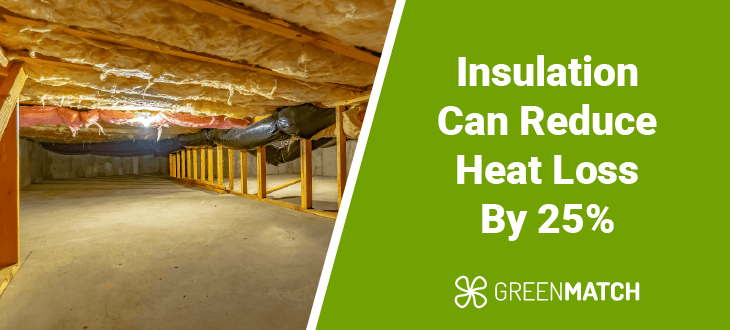
- Crawl space insulation improves energy efficiency, reduces moisture, cuts heating costs, and enhances indoor air quality.
- Proper insulation can reduce heat loss by up to 25%.
- The UK’s Great British Insulation Scheme offers financial aid, saving homeowners £300 to £400 annually on energy bills.
Crawl space insulation is key to boosting energy efficiency and lowering heating bills in UK homes, yet many properties still lack adequate insulation. Millions of UK homes are estimated to lose significant heat annually, up to 25%, through uninsulated spaces, including crawl spaces—an often overlooked area.
The UK's Great British Insulation Scheme helps families improve insulation, potentially saving £300-£400 a year. Keep reading to discover more about crawl space insulation, how to assess if your home needs it, installation tips, and how to start boosting your home's energy efficiency today.
Ready to insulate your home's crawl space and boost energy efficiency? Fill out the form below to receive up to 3 free quotes from reliable local installers. It’s quick, simple, and personalised to suit your needs. Click the button to get started!
- Describe your needs
- Get free quotes
- Choose the best offer
It only takes 30 seconds



Is crawl space floor insulation necessary?
Insulating your crawl space floor is not just for comfort—it plays a key role in improving energy efficiency and preventing moisture-related structural damage. In the UK, crawl spaces are often prone to cold, damp, and humid conditions, making proper insulation crucial for energy savings and better indoor air quality.
The Energy Saving Trust estimates that proper insulation can reduce heat loss by up to 25%, which is especially beneficial during winter. A report from Precedence Research highlights that insulating crawl spaces is vital for enhancing efficiency and minimising heat loss in homes.
Dampness and humidity, common in UK crawl spaces, can often lead to mould, wood rot, and pest infestations. Insulating with moisture-resistant materials and adding a vapour barrier helps prevent these issues.
Additionally, effective crawl space insulation improves indoor air quality by reducing moisture and allergens, protecting both your home and your health.
How to insulate your crawl space
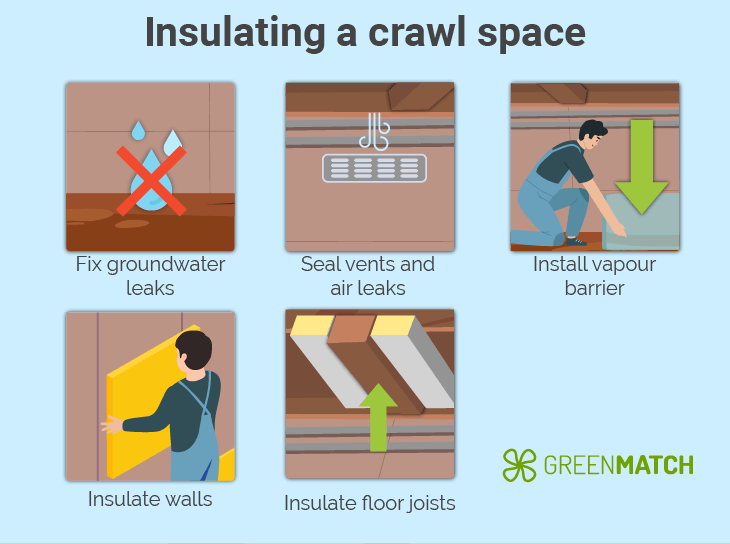
Here are the steps involved in effectively insulating a crawl space. While some aspects can be part of a DIY insulation project, more complex elements like sealing vents and ensuring proper moisture management may require professional help.
- Fix groundwater leaks: Ensure the crawl space is dry and free from water leaks before adding insulation. Water entering the space from cracks or the ground can damage insulation and lead to mould. If drainage is a persistent issue, you may need to regrade the soil around the foundation or install a sump pump.
- Seal vents and air leaks: Open vents allow cold air and moisture to enter the crawl space, reducing insulation effectiveness. Seal the crawl space vents and rim joists with rigid or spray foam boards. This step helps keep the space airtight, improving the overall thermal barrier and preventing moisture build-up.
- Install a vapour barrier: A crucial part of crawl space insulation is installing a vapour barrier. This non-permeable barrier prevents moisture from rising from the ground, reducing the risk of mould and wood rot. The barrier should cover the entire floor and extend the walls to ensure complete isolation from the earth.
- Insulate the walls: Focus on insulating the crawl space walls using moisture-resistant materials such as rigid foam boards. This prevents cold air from entering the crawl space, making it more energy efficient. Avoid traditional fibreglass, which tends to absorb moisture and can sag, becoming ineffective over time.
- Insulate floor joists (optional): For additional insulation, you may want to insulate the floor joists, especially in colder climates. Moisture-resistant insulation is crucial here, as it prevents the insulation from absorbing dampness, which could lead to sagging and mould.
Best practices for UK homes
In the UK, crawl space encapsulation is highly recommended to ensure optimal insulation. This process involves sealing vents and insulating walls and floors to prevent the "stack effect," where cold air is drawn into the home. By doing so, homeowners can avoid drafts, keep their floors warm, and protect against moisture infiltration.
DIY or hire a professional?
While some of these steps can be managed by a homeowner, laying down a vapour barrier and sealing and insulating walls properly might require professional assistance. For instance, dealing with moisture issues and installing effective seals around air leaks may be beyond DIY capabilities. Considering this, we can help you find a professional in just 30 seconds! Complete the form below to get started.
- Describe your needs
- Get free quotes
- Choose the best offer
It only takes 30 seconds



Crawl space insulation materials
When insulating crawl spaces in the UK, using materials that can handle the damp, cold conditions typical of the climate is essential. Moisture resistance, adequate insulation, and air sealing are critical for preventing mould growth and maintaining energy efficiency in UK homes.
Below is a breakdown of the suitable materials, the associated insulation R-value for crawl space insulation, and the pros and cons of each option, making them relevant for UK homeowners.
Rigid foam board insulation
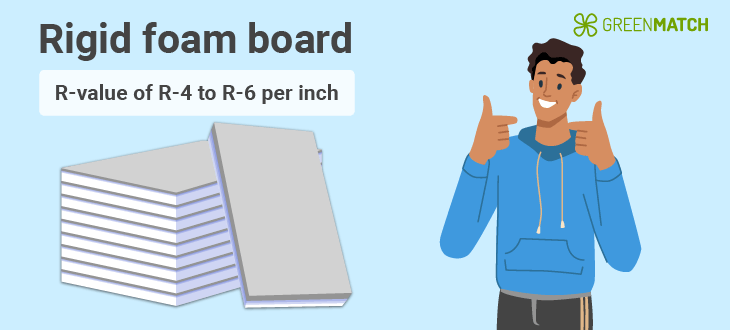
Rigid foam board insulation is ideal for UK crawl spaces due to its moisture resistance and effective thermal performance. In the UK, where damp conditions are common, this material helps prevent water absorption, which is crucial for long-term durability. The R-value ranges from R-4 to R-6 per inch, offering solid protection against heat loss.
Rigid foam boards are most commonly used for crawl space walls in the UK. Their ability to resist moisture makes them suitable for use in the UK's damp conditions.
- Water-resistant, ideal for damp UK environments.
- High insulation value per inch, providing good thermal resistance.
- It is durable and doesn’t degrade when exposed to moisture.
- Higher upfront costs compared to other materials.
- Professional installation is often required to ensure proper sealing and performance.
Spray foam insulation

Spray foam insulation, particularly closed-cell foam, works well in UK crawl spaces, particularly for air sealing. It expands to fill gaps and cracks, creating a seamless barrier that prevents cold drafts from entering the home. With an R-value of R-5 to R-7 per inch, spray foam effectively improves energy efficiency, especially in older UK homes with draughty crawl spaces.
Spray foam is ideal for sealing rim joists and insulating difficult-to-reach areas around pipes and vents where air leakage is common.
Closed-cell insulation
According to the Energy Saving Trust, closed-cell spray foam is one of the most effective insulation materials. Once applied, it forms a rigid structure, providing a strong thermal barrier and even adding some structural support to the insulated areas.
With its dense composition, closed-cell foam is less permeable to moisture, which makes it a good choice for crawl spaces where controlling humidity and preventing condensation are key concerns. However, its lack of vapour permeability means that any trapped moisture cannot escape, potentially leading to issues if not properly managed.
- Excellent for air sealing and blocking drafts, which is especially useful in older UK housing stock.
- Provides a high insulation value per inch.
- It forms a rigid barrier once applied, adding some structural support.
- It is expensive compared to other insulation options.
- Professional installation is necessary for proper application and safety.
Fibreglass batts
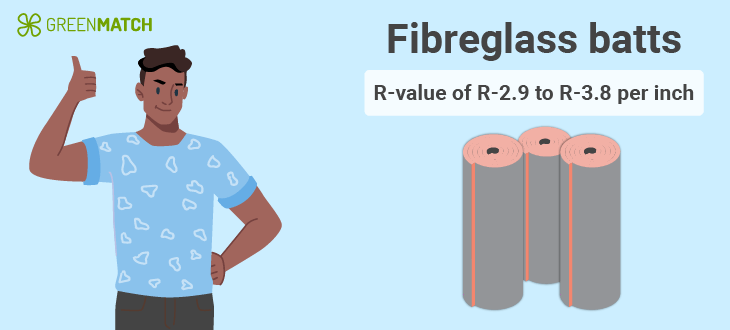
Fibreglass batts, while commonly available and the cheapest insulation option, are not ideal for the UK’s damp conditions. With an R-value of R-2.9 to R-3.8 per inch, they offer decent insulation but tend to absorb moisture, leading to sagging and mould growth in humid environments.
Fibreglass batts are mainly used for floor joists, though their performance in UK crawl spaces is limited due to the moisture-prone environment.
- It is inexpensive and readily available in the UK.
- Easy to install, making it a popular DIY option.
- Absorbs moisture, which is problematic in UK crawl spaces.
- It can sag and lose effectiveness when wet, leading to mould issues and poor insulation performance.
Vapour barrier (polyethylene)
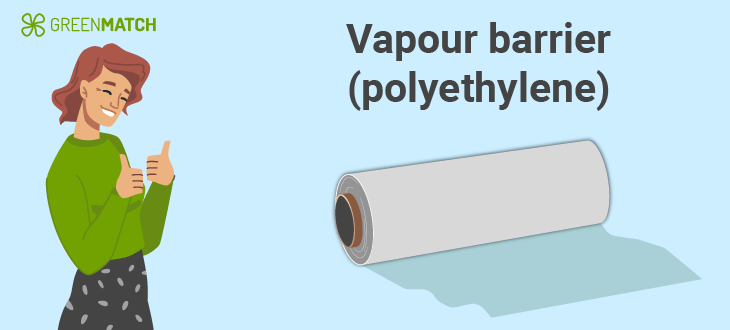
A vapour barrier is crucial for crawl space floor insulation in the UK, where dampness is common. Although it does not provide thermal insulation, it prevents moisture from seeping into the crawl space, protecting other insulation materials like rigid foam or fibreglass from becoming damp.
A vapour barrier is essential for use on the crawl space floor, especially with rigid or spray foam insulation.
- It prevents moisture from entering the crawl space, reducing the risk of mould and wood rot.
- It is durable and puncture-resistant, ensuring long-term protection against dampness.
- It does not offer any thermal insulation value, so it must be paired with other materials.
What insulation is best for a crawl space?
The best insulation for a crawl space depends on various factors, such as moisture levels, the need for air sealing, and your budget. For most UK homes, rigid foam board and spray foam insulation are the best choices for crawl space insulation. Both offer excellent moisture resistance and thermal performance, making them well-suited for the UK’s damp climate.
While fibreglass batts are cheaper, they are less effective in moist environments. Additionally, installing a vapour barrier is critical to prevent moisture from affecting the insulation and structure of the crawl space. For long-term energy savings and improved comfort, it’s worth investing in higher-quality insulation like foam boards or spray foam.
Crawl space insulation cost
In the UK, insulation prices for a crawl space are between £10 and £21.5 per square metre, depending on the material and labour involved. Based on this, the total cost of insulating a crawl space ranges from £400 to £2,500. Let’s take a look at the approximate cost of each material per m².
| Insulation material | Average cost per m² |
|---|---|
| Fibreglass batts | £10 |
| Rigid foam board | £10 - £20 |
| Spray foam | £21.5 |
| Vapour barrier | £10 |
Factors affecting costs
When considering crawl space insulation, it's essential to understand the factors that affect the overall cost. The type of insulation you choose, the size of your crawl space, and whether you hire professionals can significantly influence the price. By being aware of these factors, you can make an informed decision and balance your needs with your budget.
- Type of insulation: Different insulation materials come at varying costs. Spray foam and rigid foam boards are more expensive than fibreglass batts but offer superior moisture resistance and insulation.
- Size of the crawl space: Larger crawl spaces will require more materials, increasing the cost.
- Labour costs: Hiring professionals from insulation companies increases the overall cost, with labour typically costing £5 to £15 per square metre, depending on the complexity of the project and local rates.
- Vapour barriers and encapsulation: Adding a vapour barrier or full encapsulation can increase costs but is often necessary in damp UK climates to control moisture.
Crawl space insulation repair costs
In some cases, additional repairs are necessary to ensure the long-term functionality of a crawl space. For example, moisture issues can lead to structural damage, and addressing these problems may require both waterproofing and floor joist replacements. The cost of such repairs varies significantly depending on the severity of the damage and the crawl space's size, ranging from £1,100 to £11,000.
Waterproofing can cost between £1,200 to £12,000, depending on the solution, such as installing a vapour barrier. This barrier prevents moisture from rising into your home, protecting insulation materials and the structure from long-term water damage. Additionally, repairing or replacing floor joists - commonly affected by moisture or rot - costs around £75 to £220 per joist.
Other costs may include installing a dehumidifier (£600 to £900), which is often necessary in crawl spaces prone to high humidity. Mould removal can also be critical and costly, ranging from £850 to £2,500.
Addressing these structural issues and insulation is vital for ensuring your crawl space remains dry, stable, and energy-efficient. Failing to do so could increase costs over time due to more severe damage and inefficiencies. Proper crawl space insulation combined with repair and moisture control measures is the best way to maintain your crawl space.
Financing options
In September last year, the UK government launched the Great British Insulation Scheme, a £1 billion initiative designed to help those in need make their homes more energy-efficient.
The scheme targets families living in lower council tax bands and homes with lower energy efficiency ratings. Through this program, homeowners can receive vital upgrades, including crawl space insulation and roof, loft, or cavity wall insulation. These improvements aim to reduce energy bills by an average of £300 to £400 per year.
This scheme provides a valuable opportunity for households with uninsulated or poorly insulated crawl spaces to improve energy efficiency and reduce heating costs.
Global demand for insulation
The global building thermal insulation market is forecasted to grow significantly, with an estimated market size of USD 48.69 billion (approximately £37 billion) by 2032, reflecting a compound annual growth rate (CAGR) of 5.1%.
This increase is primarily driven by rising demand for insulation in both residential and commercial sectors, particularly in regions that experience extreme weather conditions. Insulating crawl spaces, floors, and other critical areas help maintain indoor temperatures, reducing energy consumption and cost savings.
In the context of UK homes, insulating the crawl space floor can significantly improve energy efficiency by preventing cold air from infiltrating the living areas, which reduces the strain on heating systems.
Find crawl space floor insulation specialists near you
Finding a reliable crawl space floor insulation specialist shouldn’t take up your valuable time. By using our trusted network, you can skip the hassle of searching and get connected with vetted experts near you. Not only will you save time, but you’ll also get the best options by receiving multiple quotes to compare.
Now that you know your insulation options, take the next step. Fill out the form below to receive up to 3 free, personalised quotes from local professionals. Start today, and make your crawl space and home more comfortable without the stress!
- Describe your needs
- Get free quotes
- Choose the best offer
It only takes 30 seconds



FAQ
Rigid foam board and closed-cell spray foam are generally the top choices due to their moisture resistance and high R-value. They prevent air leaks and are effective for both walls and floors, especially in damp climates like the UK.
The cost of crawl space insulation typically ranges from £10 to £45 per square metre, depending on the material used and whether professional installation is required. For an average-sized crawl space, the total cost can range from £400 to £2,500.
The cheapest insulation for a crawl space is fibreglass batts, costing around £5 to £10 per square metre for materials alone. However, it may not be ideal for damp conditions due to its tendency to absorb moisture.

Nicole Bea Kerr is a content writer for Greenmatch, leveraging her experience in B2B journalism and editing. She is interested in bringing more awareness to sustainability through informative narratives.
We strive to connect our customers with the right product and supplier. Would you like to be part of GreenMatch?

